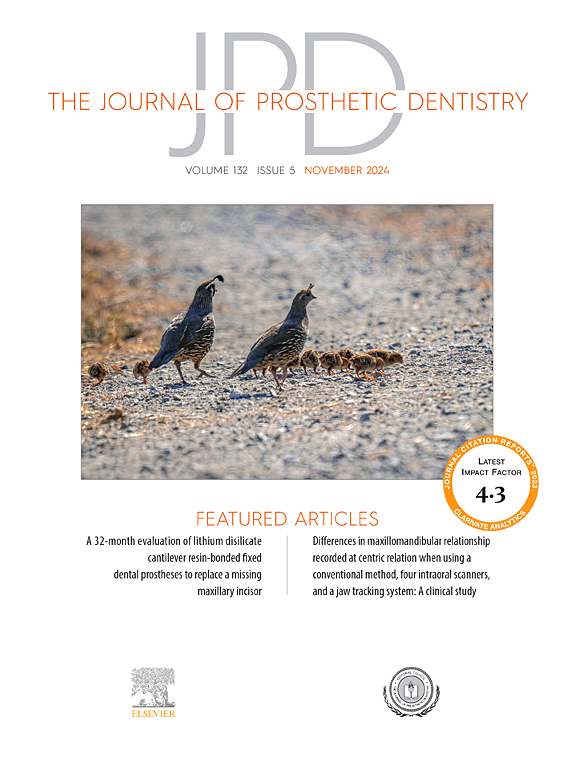不同表面处理对peek -搪瓷粘结的影响:粘结耐久性和机理。
IF 4.8
2区 医学
Q1 DENTISTRY, ORAL SURGERY & MEDICINE
引用次数: 0
摘要
问题说明:聚醚醚酮(PEEK)由于其优异的物理和生物特性已被用于临床牙科。然而,由于其化学惰性和低表面能,实现与牙釉质的有效和持久的结合是具有挑战性的,并且关于不同表面处理对peek -牙釉质结合耐久性影响的数据很少。目的:通过体外实验研究空气颗粒磨损、硫酸腐蚀及其联合使用对peek -牙釉质粘接耐久性的影响,并进一步了解其粘接机理。材料与方法:60个试样根据表面处理方式的不同分为6组:未经处理、磺化30秒、磺化60秒、气相颗粒磨损、气相颗粒磨损并磺化30秒、磺化30秒并气相颗粒磨损。对预处理后PEEK的表面形貌和理化性能进行了综合评价。在筛选了PEEK的优选表面处理策略后,通过结合强度测试、横截面形貌、分子动力学和傅里叶变换红外光谱研究了PEEK-搪漆键在5 ~ 55℃热循环(10000次)后的耐久性和结合机理。数据分析采用单因素方差分析、Weibull分析和Fisher精确检验(α= 0.05)。结果:98%硫酸蚀刻30秒和60秒组的剪切结合强度均显著高于其他两组(p)。结论:98%硫酸蚀刻60秒预处理的PEEK具有最佳的物理化学性能。这比联合蚀刻和空气颗粒磨损或单独空气颗粒磨损更好,并且在应用含mma的粘合剂时显示持久的peek -珐琅质键。本文章由计算机程序翻译,如有差异,请以英文原文为准。
Effect of different surface treatments on PEEK-enamel bonds: Bonding durability and mechanism
Statement of problem
Polyetheretherketone (PEEK) has been used in clinical dentistry because of its excellent physical and biological properties. However, achieving an effective and durable bond with enamel is challenging because of its chemical inertness and low surface energy, and data on the effects of different surface treatments on the durability of PEEK-enamel bonds are scarce.
Purpose
The purpose of this in vitro study was to investigate airborne-particle abrasion, sulfuric acid etching, and the combined use of these treatments on the bonding durability of PEEK-enamel bonds and to gain a deeper understanding of their bonding mechanism.
Material and methods
Sixty specimens were divided into 6 groups based on different surface treatments: untreated, sulfonation for 30 seconds, sulfonation for 60 seconds, airborne-particle abrasion, airborne-particle abrasion and sulfonation for 30 seconds, and sulfonation for 30 seconds and airborne-particle abrasion. Comprehensive evaluations were carried out on the surface morphology and physicochemical properties of the pretreated PEEK. After screening out the preferred surface treatment strategy of PEEK, the durability of PEEK-enamel bonds after thermal cycling (10 000 cycles at 5 to 55 °C) and the bonding mechanism were investigated by bond strength testing, cross-sectional topography, molecular dynamics,and Fourier transform infrared spectroscopy. Data were analyzed by 1-way analysis of variance, Weibull analysis, and the Fisher exact test (α=.05).
Results
The shear bond strength of the 98% sulfuric acid etching group for either 30 seconds or 60 seconds was significantly higher than that of the other groups (P<.05). Intermolecular hydrogen bonding was found between PEEK and the methyl methacrylate- (MMA-) containing adhesive resin. Cross-sectional topography showed that the adhesive resin infiltrated into the pores of the sulfonated PEEK, thereby forming micromechanical locking at the bonded interface. The bond strength between the enamel and PEEK treated with 98% sulfuric acid for 60 seconds was found to be more reliable than that observed in the group treated with 98% sulfuric acid for 30 seconds after aging (P<.05).
Conclusions
PEEK pretreated by 98% sulfuric acid etching for 60 seconds presented the best physicochemical properties. This was better than combined etching and airborne-particle abrasion or airborne-particle abrasion alone and showed durable PEEK-enamel bonds with the application of an MMA-containing adhesive.
求助全文
通过发布文献求助,成功后即可免费获取论文全文。
去求助
来源期刊

Journal of Prosthetic Dentistry
医学-牙科与口腔外科
CiteScore
7.00
自引率
13.00%
发文量
599
审稿时长
69 days
期刊介绍:
The Journal of Prosthetic Dentistry is the leading professional journal devoted exclusively to prosthetic and restorative dentistry. The Journal is the official publication for 24 leading U.S. international prosthodontic organizations. The monthly publication features timely, original peer-reviewed articles on the newest techniques, dental materials, and research findings. The Journal serves prosthodontists and dentists in advanced practice, and features color photos that illustrate many step-by-step procedures. The Journal of Prosthetic Dentistry is included in Index Medicus and CINAHL.
 求助内容:
求助内容: 应助结果提醒方式:
应助结果提醒方式:


